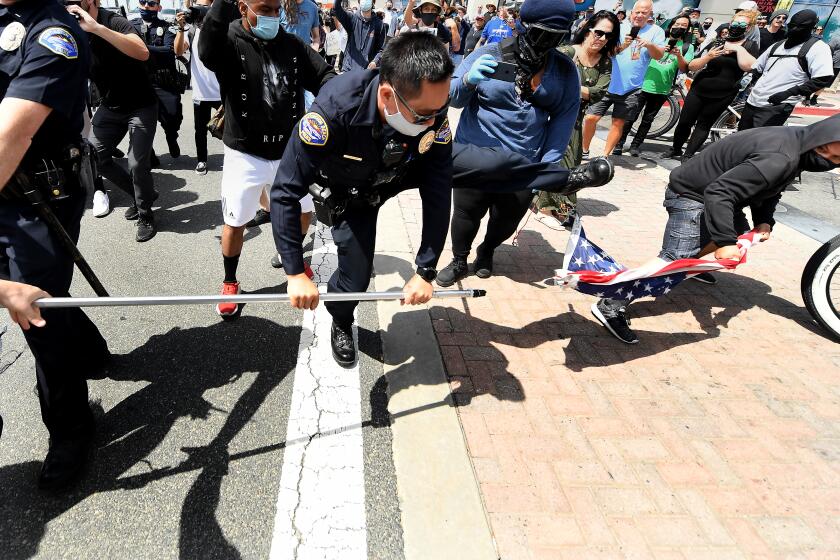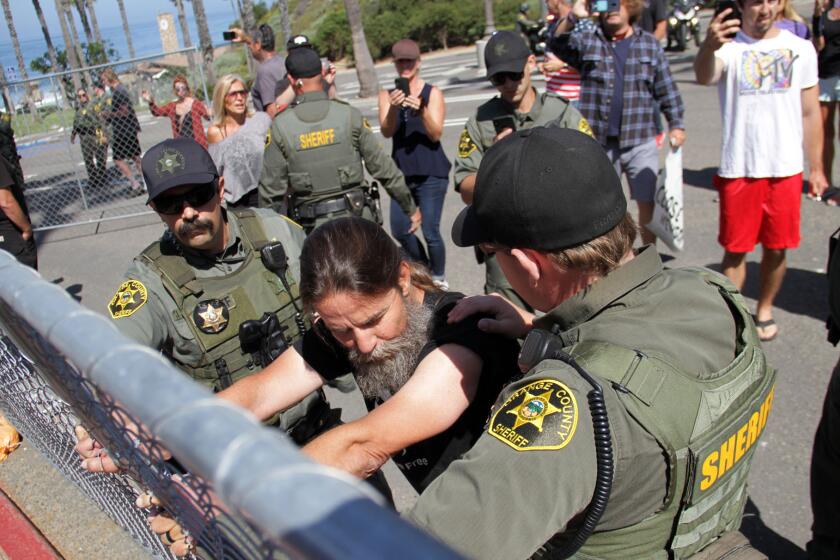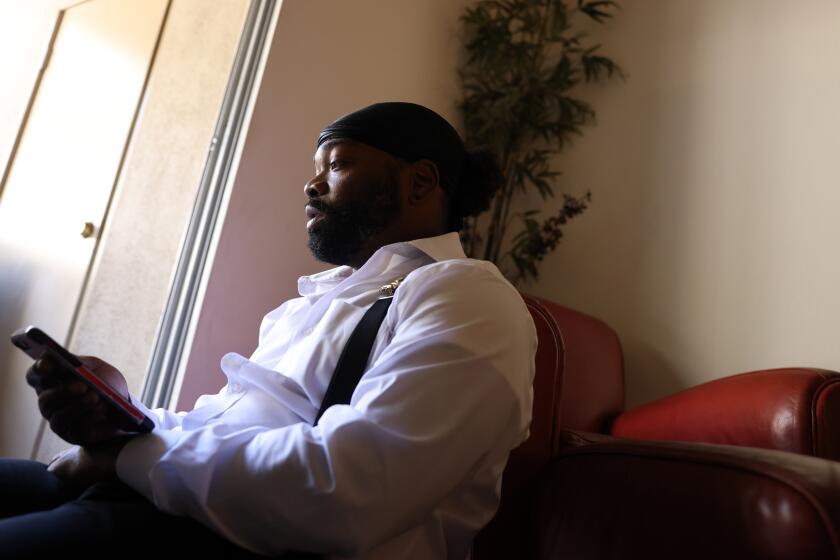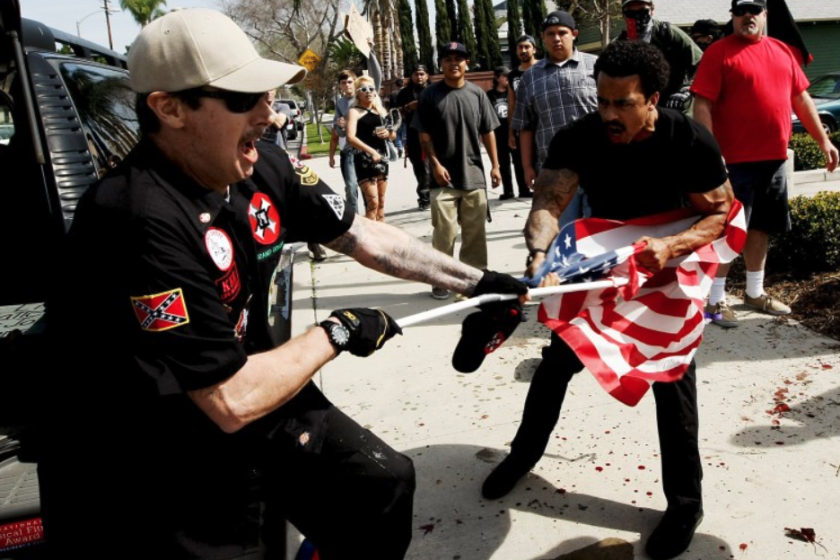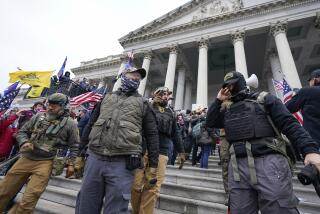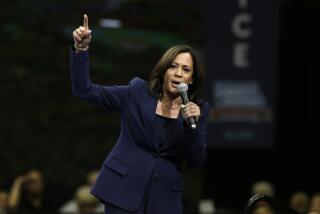âWhite Lives Matterâ rallies fizzled. Hate groups still see chance to âfire up the baseâ
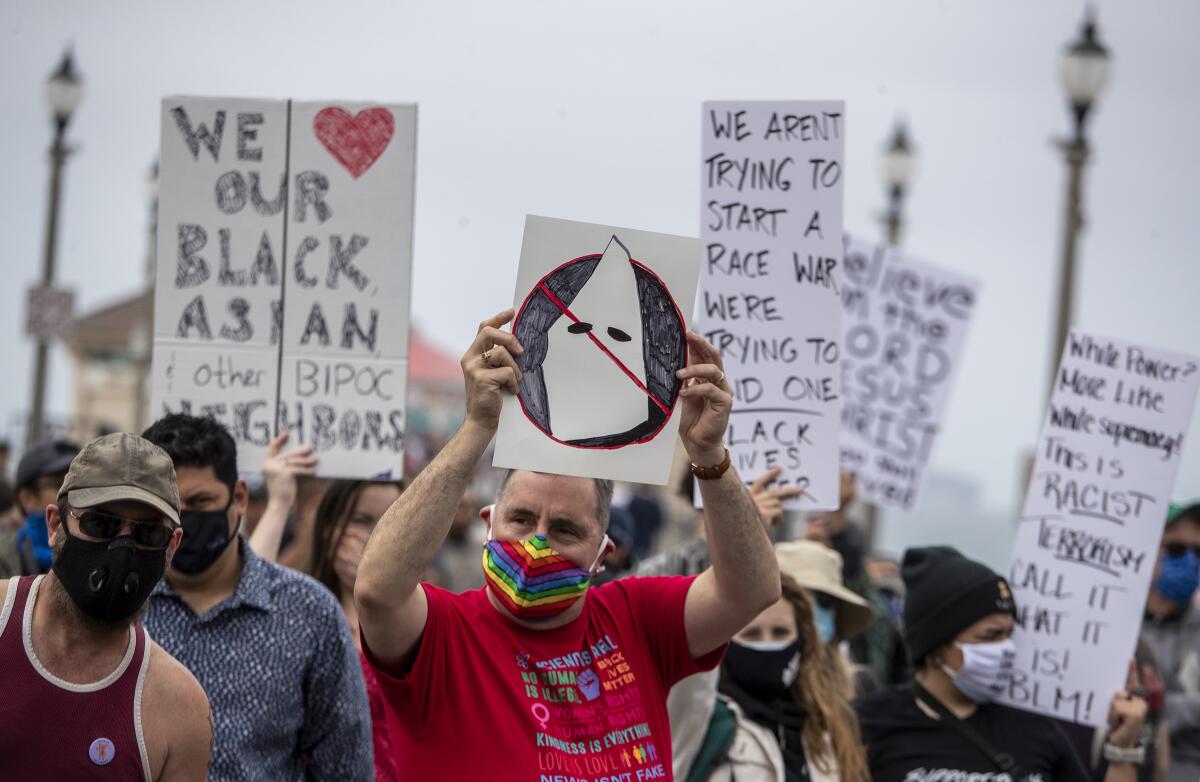
When white nationalists failed to turn out in threatening numbers Sunday at a Huntington Beach rally, many counterprotesters viewed it as a victory.
âWeâve won the day,â Los Angeles activist Najee Ali said several hours into the protest. âTheyâre not going to show up. Theyâre vastly outnumbered. The community of Huntington Beach won.â
Yet those who track extremist movements say that the truth is more complex and troubling.
Infighting, disorganization and other factors could have prevented neo-Nazis and other extremists from showing up in the kind of force seen during the deadly âUnite the Rightâ rally in Charlottesville, Va., in 2017.
But they also warn that white nationalists appear to be exploiting the eventâs small turnout â and the fact that they were overwhelmed by counterprotesters â to bolster their recruiting under the narrative that white people are under attack.
âIt feeds into the agenda that white men no longer have constitutional rights,â said Peter Levi, regional director of the Anti-Defamation League in Orange County and Long Beach. âThey try to assemble, and they canât assemble. They try to have free speech, and they canât.â
Arguments broke out among groups Sunday at the so-called White Lives Matter rally near the Huntington Beach pier.
The weekend fiasco in Huntington Beach, repeated in more than a dozen U.S. cities where similar rallies were planned, may not only play to an aggrieved base of white-centered groups but also could help them bond with other right-wing ideologies, extremist experts said. Far from signaling a breakdown of white supremacist activity, Sunday may be a curtain raiser for things to come, when issues such as immigration, border security and police reform will continue to roil politics.
âIt was a cynical publicity stunt,â said Eric Ward, an extremism expert with the Southern Poverty Law Center and Western States Center. âIt fires up the base. It makes those individuals [who attend] automatic heroes.â
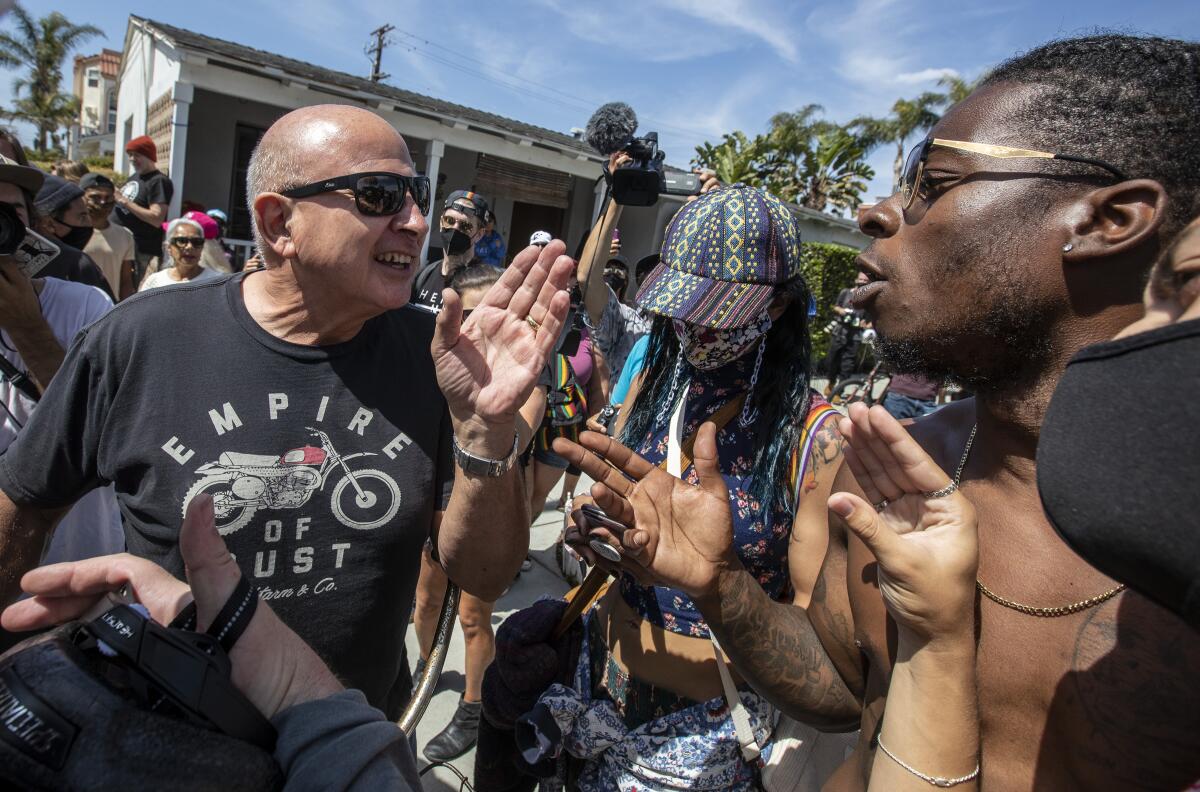
Over the last few years, counterprotesters have increasingly confronted far-right demonstrators as passions have grown on both sides. During Sundayâs event, opponents swarmed apparent supporters of white supremacy and like-minded demonstrators, often chasing them away from the Huntington Beach Pier amid chants of âNazis, go home.â
Several groups, including Black Lives Matter and the NAACP, made it clear prior to the rally that they didnât support the counterprotest. Some said the low turnout could have been a strategy, and believe white nationalist groups have used similar events in the past to bait them into confrontations.
âThey use this for lawsuits. They use this for PR. They use this for media attention, and itâs hugely problematic,â said Melina Abdullah, co-founder of Black Lives Matter Los Angeles and professor of Pan-African Studies at Cal State L.A. âWe donât want to buy into their narrative; we donât want to feed their narrative. I donât think they generally take up public space if they canât get attention.â
But Sundayâs flop wasnât just about being outnumbered.
Four members of Orange Countyâs resurgent far right spoke at a pro-Trump rally in Washington the day before the Capitol riots. Their violent rhetoric targets foes both real and imagined.
Far-right groups behind the event were hamstrung by paranoia, distrust, lack of clear organization and a desire by participants to remain anonymous â problems that became increasingly apparent in the days leading up to the rally, which was promoted on the messaging site Telegram beginning in March.
The push for âWhite Lives Matterâ rallies on April 11 prompted nearly 50 city-specific groups to organize events in several states, according to the Anti-Defamation League. Yet despite what appeared to be a vigorous and targeted promotional campaign â including Ku Klux Klan fliers in Huntington Beach, Long Beach and Newport Beach â turnout was light nationwide.
âThere is no central organizer,â wrote one administrator of Proud Boys offshoot group the Western Chauvinist, which has more than 46,000 followers on Telegram. âYOU are the organizer. If your local march doesnât happen, itâs because YOU didnât arrange one.â
In the days leading up to the rally, the Huntington Beach Police Department said it was attempting to reach organizers to âavoid surprisesâ and remind them of municipal codes and laws. But on Sunday, police spokesman Lt. Brian Smith said they had been unable to identify or contact the people behind the event.
Even William Quigg, who is known as the state leader of the Loyal White Knights faction of the Ku Klux Klan in California, did not appear to be in command Sunday, Levi said.
âIt doesnât seem like there was any real organization on the ground around these protests,â he said. âWe maybe saw 10 White Lives Matter marchers, but they didnât seem to be coordinated with each other at all, and there was no one that seemed to be in charge.â
Several planned rallies in other states and counties failed to manifest at all. In Sacramento, a sole White Lives Matter supporter showed up at McKinley Park and âquickly left,â officials said. In Fresno, a contingent of Proud Boys turned out for a weekly protest that has roiled its arts district over the sale of a landmark theater to a conservative church, a police spokesperson said.
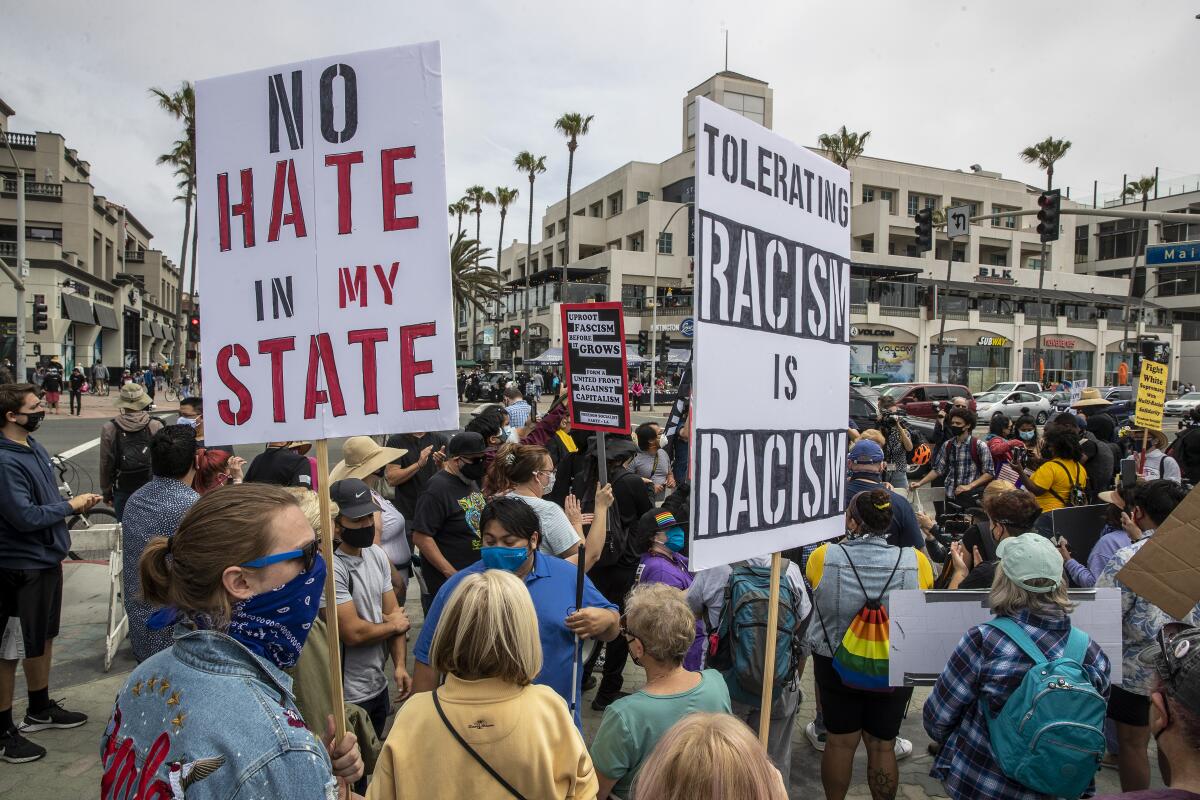
White Lives Matter organizing was also infiltrated by leftist activists who sowed confusion in its online channels on Telegram. By Sunday morning, prospective WLM demonstrators were posting their uncertainty about protest locations and other information.
On April 9, White Lives Matter organizers tried to reassure supporters about the postings, writing â90% of these have been made by good-willed patriots, while 10% have been set-up by antifa maggots â now removed.â
And while some people at the pier Sunday were overt about their ideological positions, others supported varying causes. One person waved a large Trump 2020 flag while another waved a flag emblazoned with âAll Lives Matter.â
Diane Cruzen, 65, said that she and others were there to show support for the police. âWeâre here, but weâre not here with flags, signs, things on our sweatshirts,â said Cruzen, who estimated a large portion of the crowd was opposed to the counterprotesters.
âI donât see why âBlack Lives Matterâ should be more important than âAll Lives Matter,ââ she said.
The community is planning counterprotests and pleading with public officials to do more to intervene in the face of white supremacists.
A wide mix of people show up at events such as Sundayâs rally, said experts. Some are toying with the idea of joining radical groups, some want to see what itâs about, and a third type want their views to be heard about a changing world they donât understand or are not comfortable with, said Brian Levin, director of the Center for the Study of Hate and Extremism at Cal State San Bernardino.
âThere are some people who show up knowing exactly whatâs going to be in the cereal box,â Levin said, âand there are others who are teetering and still others who are Nazi-adjacent. All these people want to be heard, but the direction and depth of their prejudices are not homogenous.â
Generating publicity is the main goal of these rallies, he said. The groups also want to demonstrate their relevance and recruit new members.
âWith these kinds of rallies, even when they fizzle, they offer a high degree of publicity, which is part of the oxygen these groups need,â Levin said. He added that âit also shows how impotent and irrelevant they are, not only with people on the mainstream, but also people on the extreme who think theyâre doing it wrong.â
The far right in Orange County remains a force and is building on a long history of extremism.
And although Sundayâs thin attendance may suggest people are increasingly unwilling to be publicly associated with white supremacy, some experts are more guarded.
Several said they expected more white nationalist activity in coming months, which could include lone-wolf violence or organized marches. On Monday, one of the white nationalist channels on Telegram promised more actions and better security and announced another event in May that would be âextremely vetted this time.â
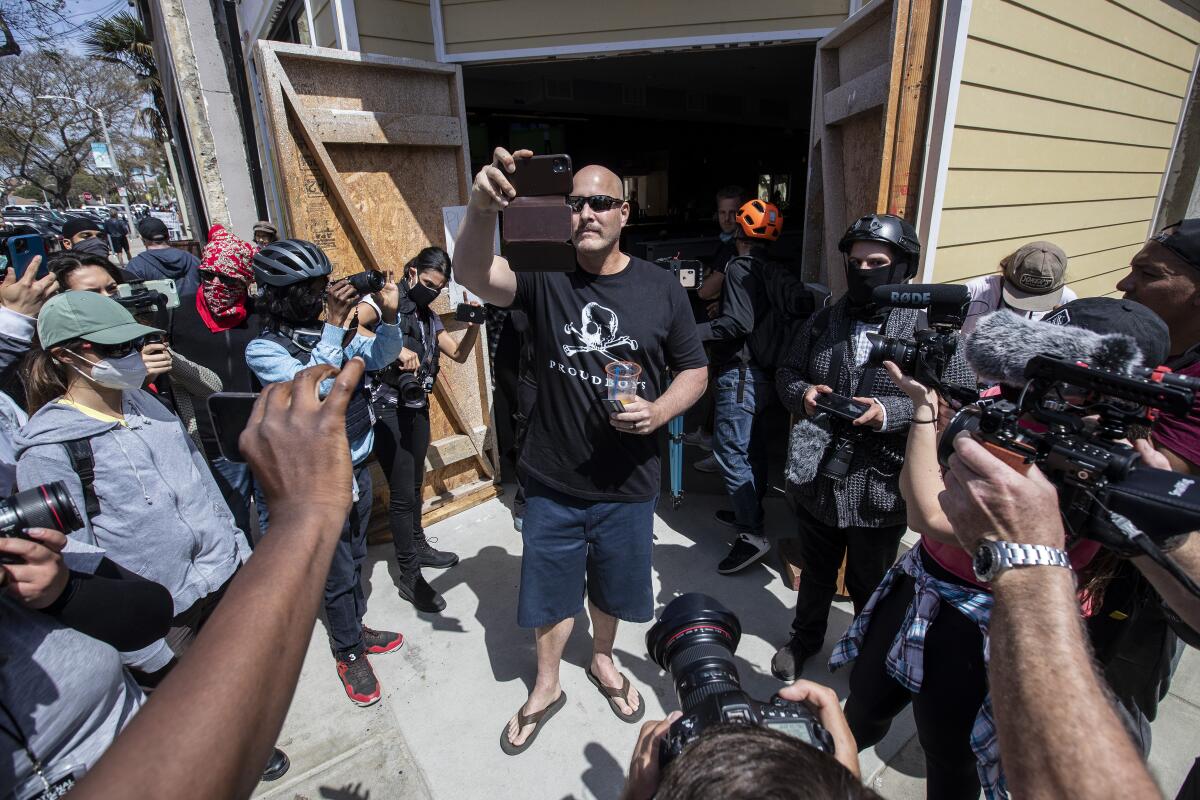
âDonât think the extremists are out of commission â theyâve just realigned in ways that are disturbing,â Levin said. âNow weâre seeing a leaner, meaner and less publicly brazen type of extremism taking place.â
Lowell Smith, chair of the criminal justice program at La Sierra University and a former Orange County law enforcement officer who specialized in far-right movements, says the groups he is monitoring hope to exploit fears about the Biden administrationâs immigration policies and other current politics.
Extremist groups claim Democrats are plotting to change the demographics of voters through illegal immigration. As the border crisis unfolds, he said racist groups would probably capitalize on it and also seize upon issues such as equity in policing. One potential flashpoint will be the juryâs decision in the trial of white former Minneapolis Police Officer Derek Chauvin in the killing of George Floyd. This week, the killing of another Black man, Daunte Wright, by a Minnesota police officer has sparked both civic unrest and blowback from conservative groups.
Underground movements, said Smith, âare going to be watching the political environments in the U.S., and they will pick and choose issues they can push.â
More to Read
Sign up for Essential California
The most important California stories and recommendations in your inbox every morning.
You may occasionally receive promotional content from the Los Angeles Times.
